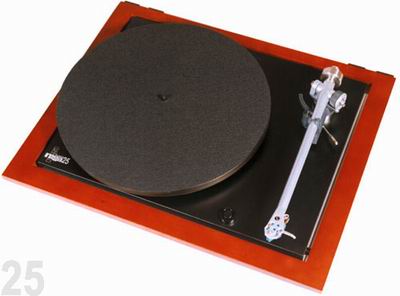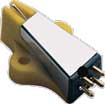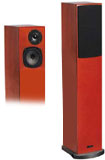A Rega System: P25, Exact, Mira and Ela
| A Rega System: P25, Exact, Mira and Ela |
|
Taking the System Approach |
|
Paul Szabady |
|
28 October 2002 |
 Specifications
Specifications
Rega P25 turntable w/ RB600 arm – $1275
Exact Moving Magnet Phono Cartridge w/ Vital stylus – $595
Mira Integrated Amplifier: 60 watts/channel – $950
Rega Ela Loudspeakers – $1395/pair
Rega Speaker Wire – $9.95/foot
Complete System Price: $4375
 Address:
Address:
Rega Research Limited
119 Park Street
Westcliff-on-Sea
Essex, England, SS0 7PD
Website: www.rega.co.uk/
E-mail service@rega.co.uk – please state country of origin. US Distributor: Lauerman Audio Import
US Distributor: Lauerman Audio Import
103 West Fifth Avenue
Knoxville TN 37915
Tel: 001 865 521 6464
Fax: 001 865 521 9494
E-Mail: realhifi@aol.com
An unchallenged assumption of high performance audio, dating back to tube days, is that choosing separate components from different manufacturers is THE path to the highest musical satisfaction. One-brand systems, largely due to the dominance of Japanese mass-market dreck, have been delegated to the mid-fi, or, worse, lo-fi categories. The art of assembling a truly fine music system focuses then on getting the diverse components to work together, to actually form a system, rather than a hodge-podge of gear (often with different design philosophies) hooked together haphazardly and working at cross-purposes. Those disinclined to develop the skill (and to budget the time) necessary to achieve this symbiosis (and without a competent dealer who has already figured it all out,) face a very frustrating experience, as simply assembling the “best” components does not guarantee musical results.

The system approach has been fiercely advocated by UK manufacturers, notably Linn, Naim and Rega. Rega has long maintained a strong and consistently realized design philosophy: musical communication above all else. Mated with Rega’s insistence on real world products at real world prices, Roy Gandy’s iconoclastic and non-audiophile approach is indeed refreshing in the world of high end audio: Forget the “sound”! Stop tweaking! Sit down and listen to the music! Radical indeed. Consider that we have the term ‘audiophile’ to denote the enthusiast of high performance audio; a love of music is not necessarily even implied.
Roy Gandy’s products focus on direct musical intelligibility and have eschewed many audiophile fads, though as their product line has evolved and expanded they are somewhat less idiosyncratic, at least as non-idiosyncratic as anything in the UK tradition of eccentricity can be. Here we have 4-inch woofers, the dominant tonearm manufacturer in the world who doesn’t produce a moving coil cartridge, turntables with dust covers and other non-audiophile-approved principles. Rega incorporates simple, down to earth and cost-effective designs – to get the basics of music reproduction really right – and tends to ignore placating the sometimes-naive demands of audiophiles.
A brief glance at Rega’s turntables reveals the anti-tweak philosophy. The turntables defy the inveterate tweaker: too short a spindle to apply clamps and record weights; non-detachable tonearm wiring stymies the arm wire crowd; non-adjustable VTA eliminates the agonized nights of wondering if the VTA was tweaked just right forthat record. There is some genuine justification for this anti-tweak stance. Tweakers can very easily fall into the trap of forgetting the whole point of an audio system and begin to fixate on changes in sound rather than on improvements to music. The gravest danger in tweaking of course, is one can completely ruin the results for which the designer aimed. One can of course, also improve upon them, a much rarer and trickier business.
Rega consciously and laboriously designs each of their products to work with the others in their line through pain-staking development and auditioning. Why no easy-adjust VTA on their arms? Because the Rega cartridges don’t need the adjustment on the Rega arms. Gandy doesn’t preclude the use of potentially discordant alien components to his systems: he just doesn’t make it easy.
I’ve had a Rega Planar 3 in various incarnations in one of my systems for all but 2 of the last 22 years and had some of my most musically rewarding listening experiences with them, so naturally I was keen to hear Gandy’s take on an entire system. Oddly, although I’d heard the P25 turntable, Exact cartridge and Ela speakers in other system contexts before, I’d never heard them all together, driven by Rega electronics and wired with Rega speaker cable. Like many UK audio products, the Rega system has some of that austere hairshirt aspect to it: no balance control or mono switch (forget tone controls: way too decadent), a straight-forward and plain physical appearance, the only concessions to sybaritic indulgence being choice of wood finishes on the P25 turntable and Ela speakers, black or aluminum finishes on the Mira integrated amp, and, a sure sign of the End of Civilization As We Know It, remote control on the Mira. The lovely deep cherrywood finish on my Ela speaker samples also follows a long British tradition.
System set-up follows Rega’s credo that hi-fi should be easy to both set up and use. Color-coded banana plugs on the Rega speaker wire (curiously yellow too), no annoying tonearm ground wire to screw with, turntable assembly and operation understandable by the slightest of glances, remote control function of the Mira integrated amp manually duplicated on the unit: this system is both non-intimidating and simple to use. The point is to listen to music, remember?
The P25 turntable includes the RB 600 arm and Rega’s new AC motor design, so low-vibration that the motor can be directly mounted to the chassis. The moving magnet Exact cartridge incorporates a line-contact Vital stylus, puts out a high 6.5 mV and uses Rega’s 3 Allen-head bolt mounting system to optimize cartridge/arm rigidity. Rega takes this seriously enough to produce a dedicated torque wrench to guarantee the correctness of this tightening. The 3-bolt mounting produces a stylus overhang that was quite short of the ideal in the 3 alignment protractors I used. Aligning the cartridge correctly precludes the use of the 3rd top bolt and bass integrity and drive suffered, though there was a slight lessening of upper midrange sibilance on vocals. Rega feels that proper overhang is not set in stone and that a firm cartridge/arm interface is more important than a small possible error in overhang, but I don’t see it as an either/or question. The solution to me is simple: change the armhole cutout so that both overhang can be standardly accurate AND the 3-point set-up used.
The Ela speaker is a floor-standing 2-way system differing from the ubiquitous UK 2-way/6-inch bass- reflex-compact-box-speakers-on-speaker-stands (though Rega also makes the type.) Though I’ve lived with many small compact speakers – mini monitors in audiophile parlance – for half of my audio life, I find the necessity for and cost of quality speaker stands to be a serious flaw in the principle. Why not just enlarge the box and thereby negate the need and cost of the stands, and get extended bass frequency response and/or efficiency to boot?
The Ela, somewhat iconoclastically, uses a 4-inch woofer loaded by a transmission line. Despite a lot of misterioso loose in the audio world about this woofer-loading technique, some hold that transmission lines do not possess any unique magic: their woofer loading, for example, fits the Thiele-Small parameters for reflex loading. Where transmission lines do have an advantage is that the in-box resonant frequency of the woofer drops compared to the driver’s free-air resonance, rather than rise as it does in reflex designs. This allows the 4-inch driver to descend lower in frequency than if reflex-loaded in the same box. Using the rudimentary Radio Shack Sound Pressure Meter and the test tones from the Stereophile Test CD2, I measured flat response (in stereo at the listening position) to 40 Hz in the smaller (18′ x 14′) of my 2 listening rooms used for this review. 31.5 Hz was only 4 dB down from the 1 kHz reference; the -10dB point was 25 Hz. All this from a 4-inch woofer. “It ain’t the meat it’s the motion.” The response was very linear throughout the range extending to 10 kHz before room roll-off dipped the top octave, which was 10 dB down. The speakers sounded better with their small driver covers attached: a slight tendency toward sibilance on some pop vocals when played naked became less of an issue.
The USA and Great Britain are separated by more than an ocean and a common language: typical listening room sizes are also polar opposites. Most UK living rooms are more literally sitting rooms, small and intimate, and generally without central heating. Compared to the pretentious ‘great rooms’ dominant in the McMansions of our suburban corporate ghettos, the average UK listening room is tiny. This provides some genuine benefits for speakers intelligently designed to exploit the positive qualities of small rooms. One – a small room won’t support the extremely low, house-shaking bass of US Godzilla speakers, so speakers can be designed for finesse, speed and articulation, rather than slobbering and drooling brute muscle. Small rooms also boost bass in a complementary manner to a speaker’s anechoic response, allowing smaller speakers with smallish woofers to sound full range in application. Small rooms also don’t require enormous power output to fill. And the close proximity of the listener enforces quality; there’s no place to hide sonic flaws. The Ela masterfully exploits all the advantages of small room placement.
The weakest link in most US audio set-ups I’ve seen is the average US living room, almost none of which seem to be compatible with an audio system. Either there is resistance to the visual domination of typical US audiophile gear (the well-known WAF) or worse, no place to put the stuff and get it operating right: lack of dimensional symmetry, inappropriate openings into other rooms, that large piece of furniture that sits where the speaker should be, etc. Yet oddly enough, most households have a spare smaller room that can be ideal places for intimate and deep music listening. I used the Rega System in 2 rooms: my bedroom loft, 19 by 16 (shooting down the long axis,) and my small living room 18 x 14 (facing the short dimension) where I did most of my listening. My large basement audiophile-approved ‘reference ‘ room, where listening is solitary worship facing the stage of the huge Soundlab Dynast electrostatics, was abandoned for this review. There was quite a difference in bass response in the two rooms: shooting the speakers down the long dimension of the larger room produced less convincing bass drive (sounding and measuring lightweight in the 100-160 Hz range) than playing them into the short dimension, where the speaker sounded full-range and was actually up 3dB at 40 Hz referenced to 1 kHz. Response at 31.5 Hz was only 4 dB down compared to 1 kHz. The speakers were placed about 20 inches from their rear wall, about 7 feet apart and 7 feet from the listener in my living room. I listened in the recommended Rega manner – just spinning discs – without worrying about toe-in and other niggles, the P25 and Mira placed atop a huge and heavy 1000 LP record cabinet.
Listening to the Rega system was deeply musically satisfying, a return to my halcyon days of ecstatic music listening during the late 60’s and early 70’s, days that often included 8 hours or more of intense listening to music on the ‘stereo’ with no attention whatsoever paid to the sound. The Rega system got immediately to the musical heart of each LP: musical expression was simply outstanding. Rhythm, timing, pulse, note definition, dynamic shading and phrasing were extraordinarily clear. Each instrument’s contribution was unambiguous and integrated into the combined effect of the other instruments – forest and trees in equal measure. There was a wholeness and integrated completeness to the playback that resulted in immediate translation into the gestalt of music. Bass lines were among the best articulated, tuneful and meaningful of any I’ve ever heard. Call and response techniques, universally archetypical in music from the Blues to the String Quartet, were stunningly produced, revealing clearly that music making is often just as much communication between the performers as with the audience. Lyric intelligibility was tops, even noted mumbling vocalists understandable.
Best of all, though, was the intense communication of the emotion and meaning of the music. I was near tears, then exultant, then full of rage, then burning with tingles running down my neck, then mellow and transported to higher planes: wherever the music led. These kinds of peak music experiences were what led me naively into the audio world 30 years ago, looking for a post-college good ‘stereo’.
It was as if the Rega System was the music source, happening right here and now, rather than dualistically and schizophrenically referring obliquely to some far-off alien event originating in a hall or recording studio. Rather than puncture the illusion of the recording and exposing its limitations, the Rega System brought out its full artistic worth. Fidelity, accuracy, soundstaging, the absolute sound? Who cares? I can’t begin to relate how refreshing this kind of listening is: the critical listening skills developed by necessity for working in retail audio and as an audio reviewer for 30 years can often be an impediment to musical satisfaction, and this is the heart of the Rega listening philosophy: bypass the intellect and its focus on analyzing the sound, and get to the heart of the music.
But 30 years of audio experience were hard to completely ignore. I turned heretic and Tweak Demon, applying various tweaks to the system to maximize its fast, incisive and crystal-clear performance. A Ringmat replaced the P25’s felt mat and the whole table went on a 3-D Seismic Sink. I defeated the spring in the arm’s tracking force adjustor and set VTF with the counterweight only. I by-passed the 3-bolt mounting of the Exact cartridge in the RB600 so that I could achieve correct overhang (this proved to be a trade-off). The Mira went up on a set of Aurios PRO Media Isolation bearings and I used a tripod TipToe set-up with A.R.T. Q-Dampers to ground the spikes in lieu of the Ela’s 4 spikes. The gains here in clarity, naturalness and transparency were simply astounding, out-“audiophiling” even the most pretentious of high-end “designer” gear, and without losing any of the un-tweaked system’s musical aptitude, rhythmic coherence, brio, and life, all of which gained significantly. I even had a groundbreaking experience with CD playback, which I used to break-in the system. The conveyance of musical sense, which the Rega System does so well, was also imparted to CD, a medium that I’ve long found painfully inept in portraying the basics of music.
I also combined the individual Rega pieces in other systems, thus willingly re-entering the hell of trying to build a system that works simpatico, a hell that the all-Rega system was designed to eliminate. My Linn Sondek’s additional bass power had the Ela’s woofer in trouble at louder volumes in my larger room, and various other electronics imposed an analytic, dissecting aspect that was inferior to the integrated gestalt the Mira achieved. (Is this why it’s called an integrated amplifier?) The Rega speaker wire, dandy with the Elas, was out of sync with my Dynastats. Finally, substituting my Origin Live Standard Kit turntable with OL RB250 arm eliminated the spring resonance of the P 25’s RB600 tracking force scheme and also allowed bolting the Exact with its 3-bolt mount AND achieve the correct overhang. This combination really sang. Bi-wiring with other speaker cable resulted in greater clarity than single wiring, but the single wired Rega speaker wire still fused more organically (I did not have a bi-wire set of Rega wires.) Significantly, and justifying Rega’s system philosophy, the individual Rega components sounded the best by far when together in the Rega System: like five fingers on the same glove. Bravo!
So it’s perfect? Well, there is a slight lack of refinement in the upper midrange performance of the Elas that could fluff sibilants, though fricatives were unaffected. This slight imperfection also added a false wiriness on certain notes to violins. This is my prime bete noire of sonic flaws, but the intense musical involvement the Rega System offered almost damped this flaw to insignificance. The effect lessened with time as the speakers broke in and with habituation, but never completely disappeared.
This Rega System gets the highest of recommendations. Used properly in the right sized room, it offers a level of musical satisfaction unmatched by much more expensive audiophile gear. I am personally quite sick of high-end audiophile gear that can’t dance, can’t sing and is distinctly mediocre in getting the basics of music right. Kudos to Roy Gandy and Rega for continuing to offer musical alternatives to the amusical dross that is often the preoccupation of the audiophile. Music Lovers, Rejoice! You have nothing to lose but your Audiophilia!
![]()
Don’t forget to bookmark us! (CTRL-SHFT-D)
Stereo Times Masthead
Publisher/Founder
Clement Perry
Editor
Dave Thomas
Senior Editors
Frank Alles, Mike Girardi, Russell Lichter, Terry London, Moreno Mitchell, Paul Szabady, Bill Wells, Mike Wright, and Stephen Yan,
Current Contributors
David Abramson, Tim Barrall, Dave Allison, Ron Cook, Lewis Dardick, John Hoffman, Dan Secula, Don Shaulis, Greg Simmons, Eric Teh, Greg Voth, Richard Willie, Ed Van Winkle, Rob Dockery, Richard Doran, and Daveed Turek
Site Management Clement Perry
Ad Designer: Martin Perry





Be the first to comment on: A Rega System: P25, Exact, Mira and Ela